
Like a seasoned climber scaling the face of a mighty ridge the morning sun inches its way up behind the timbered skyline, piercing through the pines every now and again as if teasing one with the up-and-coming promise of a brand new day.
The rooftops glisten in the early light still damp from the rogue thunderstorm that blew in the evening before.
The lingering layer of dew atop the lake transforms from thick and mysterious to virtually non-existent, unveiling a velvety sheet of glass that’s severed only by the low flying aerobatics of the occasional carp.
The air itself is crisp and clean, filled with the subtle sounds of sprightly squirrels, crooning blue jays and the scorching guitar of Eddie Van Halen, courtesy of a teeming boat of twenty-somethings about to motor out for the first ski run of the day.
This in a nutshell pretty well sums up our week here in beautiful Big Bear Lake California, a serene and scenic place that on one hand has the charming ability to hog-tie the hands of time, and on the other, the unsympathetic tendency to make time fly by as if tethered to the tail of an F-14 fighter jet.
But then isn’t that how vacations always seem to go.
Waaay too effing fast!
All the same it was one helluva fun-filled week of R & R (rest and recreation).
That said, I did manage to check a few things off my oft-abandoned To-Do list, one of which was reading the Talent Code by Daniel Coyle, a book in which (I believe) the author convincingly dispels the fabled myth that talent is inborn, and upholds the notion that, “greatness is grown.”
Now for the record, in no way does Daniel deny that by and large we are all born with some smidgen of natural talent, or that certain people are born with a bit more than others. He does however, as the late Irving Berlin alleged, endorse the belief that, “Talent is only the starting point.”
Talent is a pursued interest. Anything that you’re willing to practice, you can do… American Painter Bob Ross
While a continuing theme throughout the book, it is in the opening paragraphs of The Talent Code that the reader is first introduced to a string of mysterious places referred to as, “talent hotbeds.” Two of which are a penniless Russian tennis club that creates more top-twenty women players than the entire United States and a humble storefront music school known for producing pop music phenoms Jessica Simpson and Demi Lovato.
So, “Where does this extraordinary talent come from?” And, “How does it grow?” asks the author.
The answer he contends could begin with Clarissa, aka, “the girl who did a month’s worth of practice in six minutes,” a freckle-faced thirteen-year-old who was part of an Australian study in music psychology.
Despite being classified as a musical mediocrity possessing no musical gifts as per an aptitude test, as well as testimony of her teacher, her parents and herself, Clarissa had become famous in music-science circles.
Why?
Because of her dazzling mental capacity for, “deep practice” which according to the author is the first of, “The three key elements that will allow you to develop your gifts and optimize your performance.”
-
Element #1: Deep practice: Everyone knows that practice is key to success, writes Coyle, what everyone doesn’t know is that specific kinds of practice can increase skill up to 10 times faster than conventional practice.
-
Element #2: Ignition: We all need a little motivation to get started, but what is it that separates truly High Achievers from the rest of the pack?
-
Element #3: Master Coaching: What are the secrets of the world’s most effective teachers, trainers and coaches?
Now while it’s crystal clear throughout the book that Mr. Coyle has done his homework, and while his research is both compelling and convincing, I must confess that all the scientific chatter about a neural insulator called myelin (a microscopic substance described as insulin that rocks nerve fibers in our brains to help increase signal strength, speed and accuracy) had me drifting in and out of the snooze zone on more than one occasion.
No disrespect to Mr. Coyle, it’s just that, well, input and output paths aren’t really my thing.
From the get-go the author emphasizes that, “This book is about a simple idea,” yet in my honest opinion it is nowhere as simple, as memorable, or as utterly entertaining as the 5 minute video Daniel posted on his website entitled, “Daddy messing up: a touching journey,” which recounts a popular Nike commercial featuring Tiger Woods and his, “natural ability” to juggle a golf ball with a pitching wedge.
Shortly after it’s airing in 2009 Dateline NBC did a piece on this now legendary Nike commercial, touting Tiger’s abilities as, “Pure magic.”
“Something others can only dream about.”
“Gotta be a trick right? After all no human can do this.”
In the segment it was also noted that it took a total of four takes for Tiger to successfully execute the entire maneuver. Daniel’s homespun video on the other hand was filmed over the course of approximately 3 months with the average practice time lasting a few minutes each day.
90 days, a few minutes each day, that’s how long it took him to master that which allegedly no mere mortal could ever hope to accomplish. And ironically enough, Daniel doesn’t even play golf.
Unfortunately I couldn’t find this video anywhere, however although not in its entirety the essence of it is highlighted in the first few minutes of this TEDx event.
I also located some similar videos on YouTube which like Daniels reaffirm a very “simple” truth:
With a little time and effort you can develop talents that you never knew you had, not to mention, were likely ever born with
Pure magic? My eye!
PS Needless to say we’re all familiar with Nike’s famed tagline, “Just Do it” and as such I thought it interesting to note that in chapter one of The Talent Code, subsequent to referencing a number of case in point examples as well as a catalogue of scientific research, the author himself recognizes that, “The best way to understand the concept of deep practice, ‘is to do it.’”
Now ya gotta admit, it don’t get much simpler than that.
See ya soon, till then, keeep it up.



